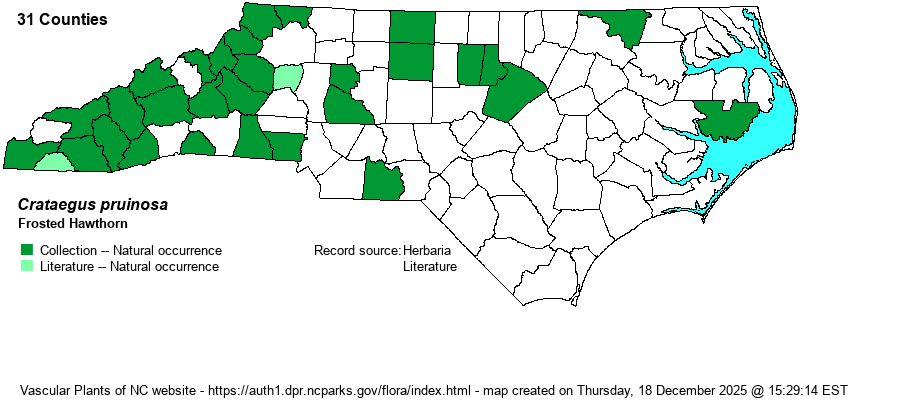| Author | (H.L. Wendland) K. Koch | |
| Distribution | Occurs throughout the Mountains, but scattered over the Piedmont and northern Coastal Plain. Details of the range are not well known, especially east of the Mountains. Adding to uncertainty is that there are 3-4 varieties of this species in the state. The map below likely underestimates the range in the Piedmont.
A broad Eastern range, from southern Canada south into GA and northern LA.
| |
| Abundance | Apparently common in the Mountains -- as Lance (2014) gives it as "common" in the state and there are numerous specimens in most Mountain counties, but rare to uncommon in the Piedmont; very rare in the northwestern Coastal Plain. Probably most numerous in the northern Mountains, as it is considered as common in the VA Mountains and it has a Northern distribution. Because it is not in the NCNHP database, this website has given a state rank of S4?. | |
| Habitat | This is a species of dry, often rocky sites, such as mountain balds and rock outcrop margins, upland forests, and upland thickets. |
| Phenology | Blooms in April and May, and fruits in September and October.
| |
| Identification | This is a large shrub or small tree, to 15-20 feet tall. As what is considered as C. pruinosa consists of 3-4 varieties in the state, generalized characters can be hard to describe. The leaves are fairly typical ovate to deltoid (triangular) in shape, with strong serrations and sometimes a few short lobes. As a general rule, the leaves and inflorescences of this species are glabrous. Also, despite the “pruinose” part of the name, the fruit are no more glaucous/pruinose than on several other species, though most individuals at least have quite a strong whitish bloom on the fruit. Plants usually produce abundant fruit in the fall. It can often form thickets in sunny or disturbed sites. Though this is hardly a scarce species in the mountains, and should be seen from time to time there, most people will need to collect a twig to key out to be sure of the identification. Father downstate, the species is likely seen quite infrequently and would easily be overlooked. | |
| Taxonomic Comments | Lance (2014) indicates that four varieties occur in the state – var. pruinosa, var. gattingeri, var. dissona, and var. rugosa. Weakley (2018) considers var. gattingeri to be a full species – C. gattingeri [Gattinger’s Hawthorn], but he does consider the other three as variants in the state, with the nominate var. pruinosa as the most numerous one. RAB (1968) mentions C. pruinosa and C. rugosa [as species] but as being subsumed in the very large catch-all C. flabellata.
| |
| Other Common Name(s) | Waxy-fruited Hawthorn, Waxyfruit Hawthorn | |
| State Rank | [S4?] * | |
| Global Rank | G5 | |
| State Status | | |
| US Status | | |
| USACE-agcp | | |
| USACE-emp | | |

